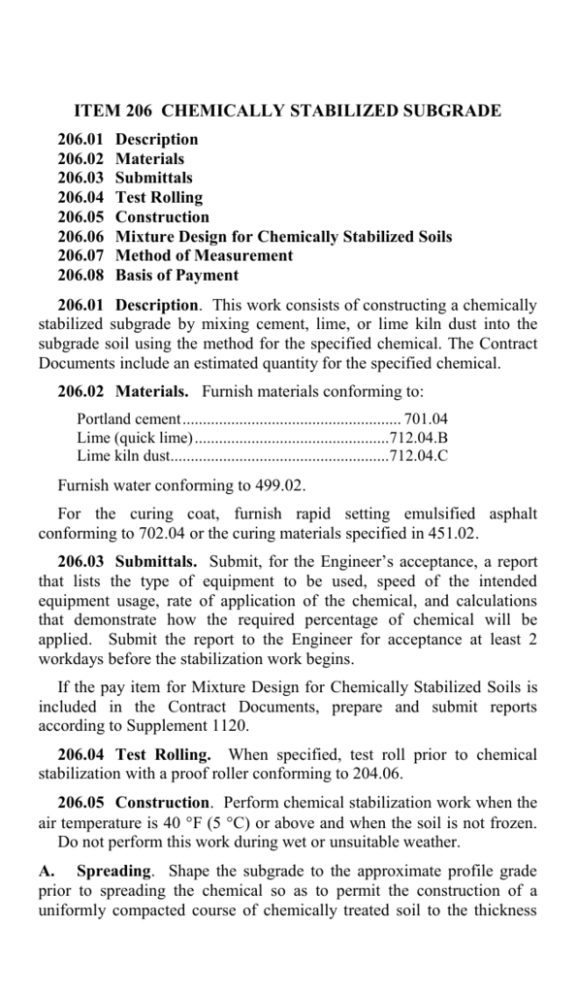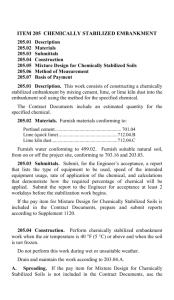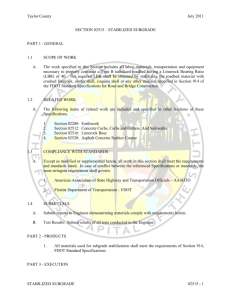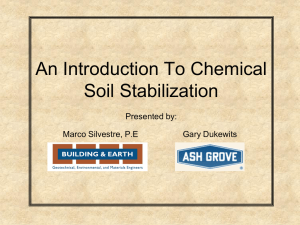206_10162009 - Ohio Department of Transportation
advertisement

ITEM 206 CHEMICALLY STABILIZED SUBGRADE 206.01 206.02 206.03 206.04 206.05 206.06 206.07 206.08 Description Materials Submittals Test Rolling Construction Mixture Design for Chemically Stabilized Soils Method of Measurement Basis of Payment 206.01 Description. This work consists of constructing a chemically stabilized subgrade by mixing cement, lime, or lime kiln dust into the subgrade soil using the method for the specified chemical. The Contract Documents include an estimated quantity for the specified chemical. 206.02 Materials. Furnish materials conforming to: Portland cement ...................................................... 701.04 Lime (quick lime) ................................................712.04.B Lime kiln dust......................................................712.04.C Furnish water conforming to 499.02. For the curing coat, furnish rapid setting emulsified asphalt conforming to 702.04 or the curing materials specified in 451.02. 206.03 Submittals. Submit, for the Engineer’s acceptance, a report that lists the type of equipment to be used, speed of the intended equipment usage, rate of application of the chemical, and calculations that demonstrate how the required percentage of chemical will be applied. Submit the report to the Engineer for acceptance at least 2 workdays before the stabilization work begins. If the pay item for Mixture Design for Chemically Stabilized Soils is included in the Contract Documents, prepare and submit reports according to Supplement 1120. 206.04 Test Rolling. When specified, test roll prior to chemical stabilization with a proof roller conforming to 204.06. 206.05 Construction. Perform chemical stabilization work when the air temperature is 40 F (5 C) or above and when the soil is not frozen. Do not perform this work during wet or unsuitable weather. A. Spreading. Shape the subgrade to the approximate profile grade prior to spreading the chemical so as to permit the construction of a uniformly compacted course of chemically treated soil to the thickness shown on the plans. The addition of the chemical will raise the subgrade profile approximately 1 inch (25 mm). Remove this excess material during the fine grading. If the pay item for Mixture Design for Chemically Stabilized Soils is not included in the Contract Documents, use the following spreading percentage rate for the specified chemical. The percentage is based on a dry density for soil of 110 pounds per cubic foot (1760 kg/m3): TABLE 206.05-1 Chemical Cement Lime Lime Kiln Dust Spreading Rate 6% 4% 8% Spread the chemical uniformly on the subgrade using a mechanical spreader at the approved rate and at a constant slow rate of speed. Use a distribution bar with a maximum height of 3 feet (1 meter) above the subgrade. Use a canvas shroud that surrounds the distribution bar and extends to the subgrade. Minimize dusting when spreading the chemical. Control dust according to 107.19. Do not spread the chemical when wind conditions create blowing dust that exceeds the limits in 107.19. Do not spread the chemical on standing water. B. Mixing. Immediately after spreading the chemical, mix the soil and chemical as follows. 1. Cement or Lime Kiln Dust. Mix the chemical and soil using a power driven transverse type mixer equipped with a computer controlled volumetric water readout. Continue mixing until the cement or lime kiln dust is thoroughly incorporated into the soil and is a uniform color. Do not water during the initial mixing. Perform the initial mixing so that 60 percent of the soil mixture passes the No. 4 sieve (4.75 mm) and 100 percent passes the 1 inch sieve (25mm), exclusive of aggregate larger than the No. 4 sieve (4.75 mm) size. After the initial mixing, remix the soil and introduce water through the mixer to bring the mixed material to at least optimum moisture. Uniformly distribute the water in sufficient quantity to hydrate the cement or lime kiln dust. If the chemical and soil can be mixed to the required gradation and the water can be added to bring the soil mixture to the required moisture content in one mixing, then only one mixing of the soil, water and chemical is required. Restrict the addition of water when the moisture content of the soil exceeds 3 percent above optimum moisure. Add water to the mixed soil within 2 hours after the initial mixing. Once the water is added to the mixture, complete the mixing, compacting, and shaping within 2 hours from start to finish. 2. Lime. Mix the lime and soil using a power driven transverse type mixer equipped with a computer controlled volumetric water readout. If necessary, add water to bring the mixed material to at least 3 percent above optimum moisture content. Continue mixing until the lime is thoroughly incorporated into the soil, all soil clods are reduced to a maximum size of 2 inches (50 mm), and the mixture is a uniform color. After the initial mixing, lightly compact the material to seal it against rain or excessive drying by using a steel wheel or pneumatic tire roller. Allow the lime and soil mixture to cure (mellow) for a period of not less than 24 hours and not more than 7 days. If more than 7 days elapse between initial mixing and final mixing, add an additional 0.5 percent of lime during the final mixing. Furnish the additional lime at no cost to the Department unless the delay beyond the 7-day limit is caused by conditions beyond the Contractor’s control. Perform the final mixing until the soil mixture is completely pulverized with all clods reduced to a maximum size of 1 inch (25 mm) and at least 60 percent of the clods passing the No. 4 (4.75 mm) sieve, exclusive of aggregate larger than the No. 4 sieve (4.75 mm). Continue mixing until the lime is uniformly distributed throughout the pulverized soil. During final mixing, return the mixture to the moisture contents stated above, then shape and compact the mixture. 3. Mixture Depth Check. Check the uniformity of the mix by digging trenches or a series of holes at regular intervals for the full depth of treatment and inspecting the color and depth of the exposed material. The Engineer will use diluted hydrochloric acid or phenolphthalein to ensure that the chemical is mixed to the desired depth. C. Compacting. Start compaction no more than 30 minutes after the final mixing. Compact all chemically stabilized subgrade to the requirements in 204.03, except the Engineer will use 98 percent of the maximum dry density for acceptance. The Engineer will obtain the maximum dry density for acceptance by using the Ohio Typical Moisture Density Curves, the moisture density curves from the Contractor’s mixture design submittal, or the maximum dry density obtained by test section method. Use a vibratory footed roller weighing at least 10 tons (9 metric tons). Use the moisture controls according to 203.07.A, except ensure that the moisture content at time of compaction is at or above optimum. Perform the final rolling using a steel-wheeled roller. Do not use vibration during the final rolling. Shape and fine grade the compacted chemically stabilized subgrade to the profile grade and typical sections within the tolerances in 203.08. D. Curing. Immediately after the compaction, shaping and fine grading of the chemically stabilized subgrade, cover the surface with curing coat for curing the chemically stabilized subgrade. Use a rate of 1 gallon per 30 square feet (1.36 liters per square meter) for emulsions or a rate of 1 gallon per 150 square feet (0.27 liters per square meter) when the curing materials in 451.02 are used. Apply the curing coat prior to the surface drying out. If the curing coat is delayed or the surface starts to dry out, indicated by turning white, apply water for temporary curing until the curing coat can be applied. Do not apply the curing coat unless the curing coat can set up before it rains. When the application of curing coat must be delayed, keep the chemically stabilized subgrade wet by using water until the curing coat can be applied. Cure the chemically stabilized subgrade for at least five days before the placement of the overlying course. E. Proof Rolling. After the cure period, proof roll the chemically stabilized subgrade according to Item 204. F. Protection. Drain and maintain the work according to 203.04.A. Do not operate any equipment on the chemically stabilized subgrade during the cure period. Do not allow the chemically stabilized subgrade to freeze during the cure period. Cover the completed chemically stabilized subgrade with the aggregate base within 60 calendar days. 206.06 Mixture Design for Chemically Stabilized Soils. When included in the plans, perform a mixture design for chemically stabilized soils according to Supplement 1120. 206.07 Method of Measurement. The Department will measure chemically stabilized subgrade by the number of square yards (square meters) computed from the profile grade and typical sections accepted in place. The Department will measure cement, lime, and lime kiln dust by the number of tons (metric tons) incorporated in the complete and accepted work. The Department will measure Test Rolling according to 204.08 as specified for Proof Rolling. The Department will measure Curing Coat by the number of square yards (square meters) computed from the profile grade and typical sections accepted in place. 206.08 Basis of Payment. The Department will pay lump sum for all work, labor, and equipment described in 206.06. The Department will pay two-thirds of the lump sum amount bid when the soil sampling and testing is complete and the report is accepted by the Department. The Department will pay one-third of the lump sum amount bid when the chemically stabilized subgrade is completed and accepted by the Department. The Department will pay for accepted quantities at the contract prices as follows: Item Unit Description 206 Square Yard (Square Meter) Square Yard (Square Meter) Square Yard (Square Meter) Ton (Metric Ton) Ton (Metric Ton) Ton (Metric Ton) Square Yard (Square Meter) Hour Lump Sum Cement Stabilized Subgrade, __inches deep Lime Stabilized Subgrade, __ inches deep Lime Kiln Dust Stabilized Subgrade, __ inches deep Cement Lime Lime Kiln Dust Curing Coat 206 206 206 206 206 206 206 206 Test Rolling Mixture Design for Chemically Stabilized Soils







